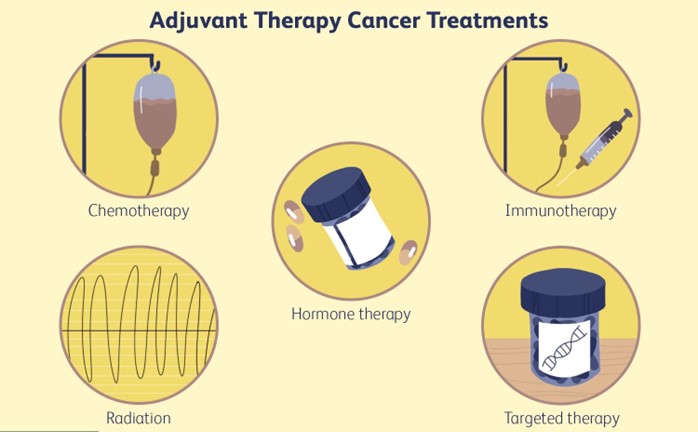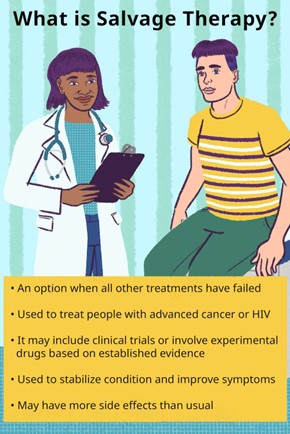Chemotherapy Agents and Oncology Pharmacology > Pharmacology
Exam Review
Introduction
Total Questions : 5
Showing 5 questions, Sign in for moreA nurse is caring for a client who is receiving adjuvant chemotherapy after surgery for colon cancer. The nurse should explain to the client that the purpose of this type of chemotherapy is to:
Explanation
Choice A reason:
This is incorrect because shrinking the tumor before surgery and making it easier to remove is the purpose of neoadjuvant chemotherapy, not adjuvant chemotherapy. Neoadjuvant chemotherapy is given before the primary treatment, while adjuvant chemotherapy is given after the primary treatment.
Choice B reason:
This is correct because eliminating any remaining cancer cells and preventing recurrence is the main goal of adjuvant chemotherapy. Adjuvant chemotherapy is given after the primary treatment, usually surgery, to lower the chance that the cancer will return and to improve the outcome of firstline treatment.
Choice C reason:
This is incorrect because inducing remission and reducing the tumor burden is the purpose of induction chemotherapy, not adjuvant chemotherapy. Induction chemotherapy is given as the firstline treatment to achieve a complete or partial response.
Choice D reason:
This is incorrect because relieving symptoms and improving quality of life is the purpose of palliative chemotherapy, not adjuvant chemotherapy. Palliative chemotherapy is given to patients with incurable or terminal cancer to reduce pain and suffering.

A nurse is reviewing the medication orders for a client who is receiving neoadjuvant chemotherapy for breast cancer. The nurse should identify that this client will receive chemotherapy drugs that are:
Explanation
Choice A reason:
This is incorrect because cell cyclespecific chemotherapy drugs are drugs that act on cancer cells during specific phases of the cell cycle. They have a narrow spectrum of activity because they only affect cells that are actively dividing. Cell cyclespecific drugs are not necessarily used for neoadjuvant chemotherapy.
Choice B reason:
This is incorrect because cell cyclenonspecific chemotherapy drugs are drugs that act on cancer cells regardless of their phase in the cell cycle. They have a broad spectrum of activity because they affect both dividing and nondividing cells. Cell cyclenonspecific drugs are not necessarily used for neoadjuvant chemotherapy.
Choice C reason:
This is incorrect because cell cyclespecific chemotherapy drugs are drugs that act on cancer cells during specific phases of the cell cycle. They have a broad spectrum of activity because they affect both dividing and nondividing cells. Cell cyclespecific drugs are not necessarily used for neoadjuvant chemotherapy.
Choice D reason:
This is incorrect because cell cyclenonspecific chemotherapy drugs are drugs that act on cancer cells regardless of their phase in the cell cycle. They have a narrow spectrum of activity because they only affect cells that are actively dividing. Cell cyclenonspecific drugs are not necessarily used for neoadjuvant chemotherapy.
Choice E reason:
This is correct because neoadjuvant chemotherapy is treatment with drugs before the main treatment, usually surgery or radiation therapy, to shrink the tumor and improve the outcome of the main treatment. Neoadjuvant chemotherapy can also help with surgical planning and early treatment of microscopic metastatic foci. Neoadjuvant chemotherapy is often given in combination with other modalities such as radiation or surgery.
A nurse is administering induction chemotherapy to a client who has acute myeloid leukemia (AML). The client asks the nurse what induction chemotherapy means. The nurse should respond by saying:
Explanation
Choice A reason:
This is incorrect because chemotherapy given before other treatments to shrink the leukemia cells is called neoadjuvant chemotherapy, not induction chemotherapy. Neoadjuvant chemotherapy is used to improve the outcome of the main treatment, such as surgery or radiation therapy.
Choice B reason:
This is incorrect because chemotherapy given after other treatments to kill any leftover leukemia cells is called adjuvant chemotherapy, not induction chemotherapy. Adjuvant chemotherapy is used to lower the chance of leukemia recurrence and improve the outcome of the firstline treatment.
Choice C reason:
This is correct because induction chemotherapy is the firstline or initial treatment of cancer, usually with high doses of anticancer drugs, before another treatment such as consolidation or postremission therapy. The goal of induction chemotherapy is to cure the cancer, destroy as many cancer cells as possible, suppress distant metastases, and shrink the tumor.
Choice D reason:
This is incorrect because chemotherapy given to control symptoms and improve quality of life is called palliative chemotherapy, not induction chemotherapy. Palliative chemotherapy is used for patients with incurable or terminal cancer to reduce pain and suffering.
A nurse is caring for a client who has ovarian cancer and is receiving palliative chemotherapy. The client tells the nurse that she feels hopeless and wonders why she is still taking the drugs. The nurse should respond by saying:
Explanation
Choice A reason:
This is incorrect because it may sound dismissive of the client's feelings and imply that palliative chemotherapy can only prolong life, not improve quality of life. Palliative chemotherapy is not meant to cure cancer or to extend life significantly, but to relieve the symptoms of cancer and improve quality of life.
Choice B reason:
This is incorrect because it may give false hope to the client and contradict the purpose of palliative chemotherapy. Palliative chemotherapy is unlikely to cure cancer or induce remission, even if the client responds well.
Choice C reason:
This is incorrect because it may suggest that the nurse does not support the client's decision to continue treatment or that palliative chemotherapy is futile. Palliative chemotherapy is optional and the client has the right to refuse treatment, but the nurse should respect the client's wishes and provide information and support.
Choice D reason:
This is correct because it shows empathy and compassion for the client's feelings and acknowledges the benefits of palliative chemotherapy. Palliative chemotherapy can relieve some of the symptoms and discomforts caused by cancer, such as pain, nausea, fatigue, etc.
A nurse is educating a client who has prostate cancer and is receiving salvage chemotherapy after failure of previous treatments. The nurse should inform the client that salvage chemotherapy:
Explanation
Choice A reason:
Salvage chemotherapy is not given to prevent relapse or progression of the disease, but rather to treat it when it has already relapsed or progressed. Preventive chemotherapy is usually given after the initial treatment has achieved a complete response, to reduce the risk of recurrence.
Choice B reason:
This is the correct answer. Salvage chemotherapy is given to control advanced or refractory disease, meaning that the disease has not responded to or has become resistant to previous treatments. Salvage chemotherapy aims to stabilize the disease, prevent further complications, and improve symptoms and quality of life. ³⁴
Choice C reason:
Salvage chemotherapy is not given to induce remission or reduce tumor burden, but rather to control it when it has already become unresponsive or resistant to previous treatments. Induction chemotherapy is usually given as the firstline treatment for aggressive cancers, to shrink the tumor before surgery or radiation therapy.
Choice D reason:
Salvage chemotherapy is not only given to relieve symptoms and improve quality of life, but also to control the disease and prevent further complications. Symptom relief and quality of life improvement are important goals of salvage chemotherapy, but they are not the only ones. ³⁴:

Sign Up or Login to view all the 5 Questions on this Exam
Join over 100,000+ nursing students using Nursingprepexams’s science-backend flashcards, practice tests and expert solutions to improve their grades and reach their goals.
Sign Up Now

